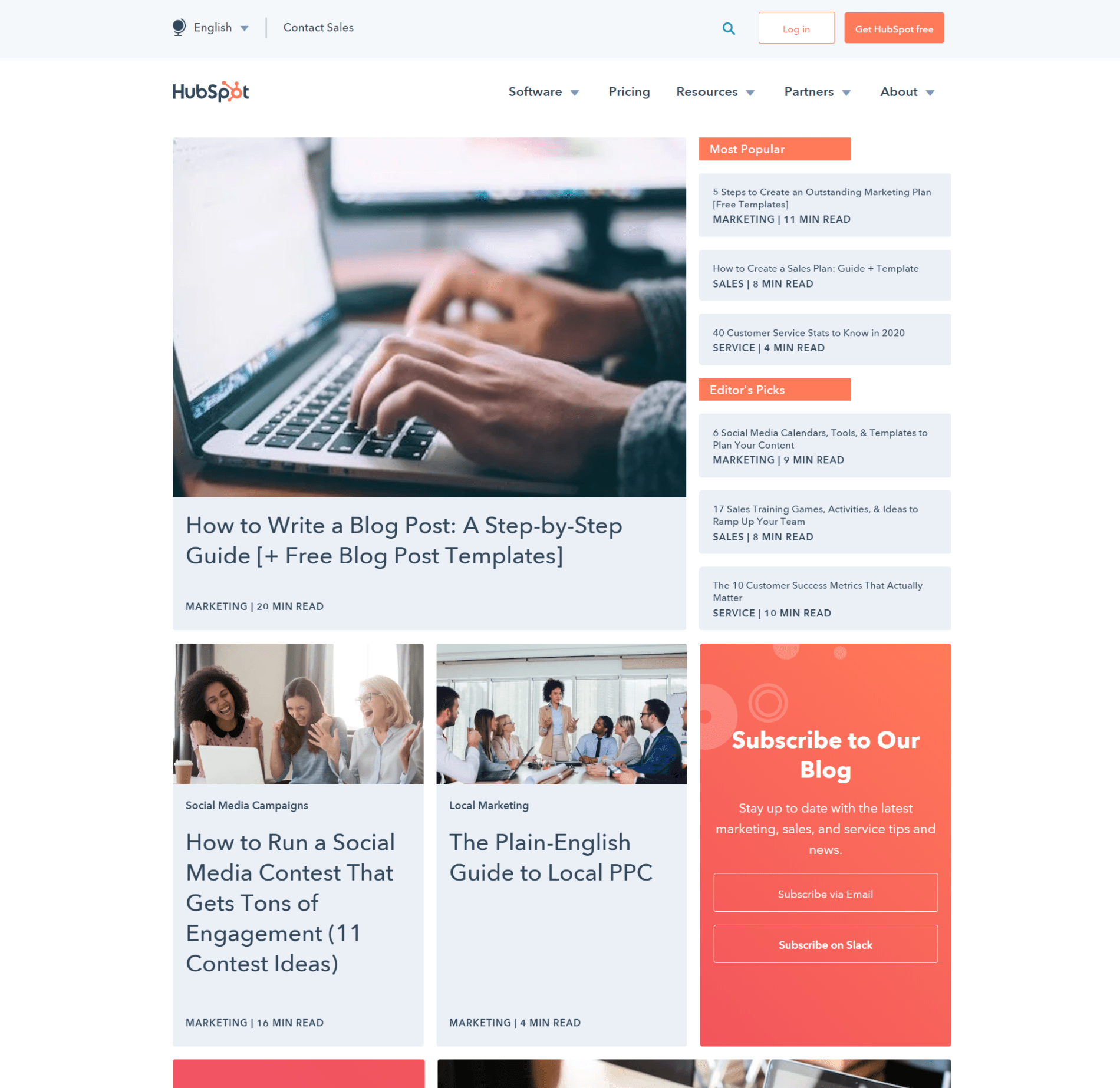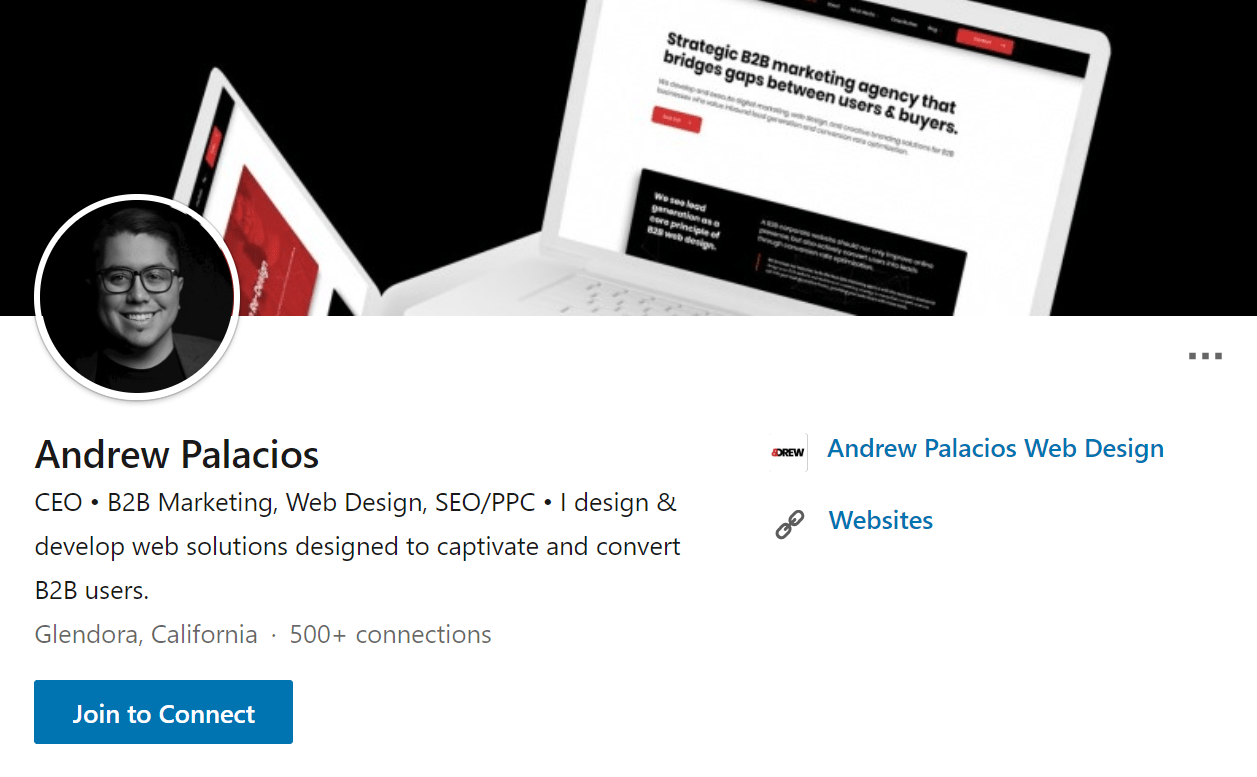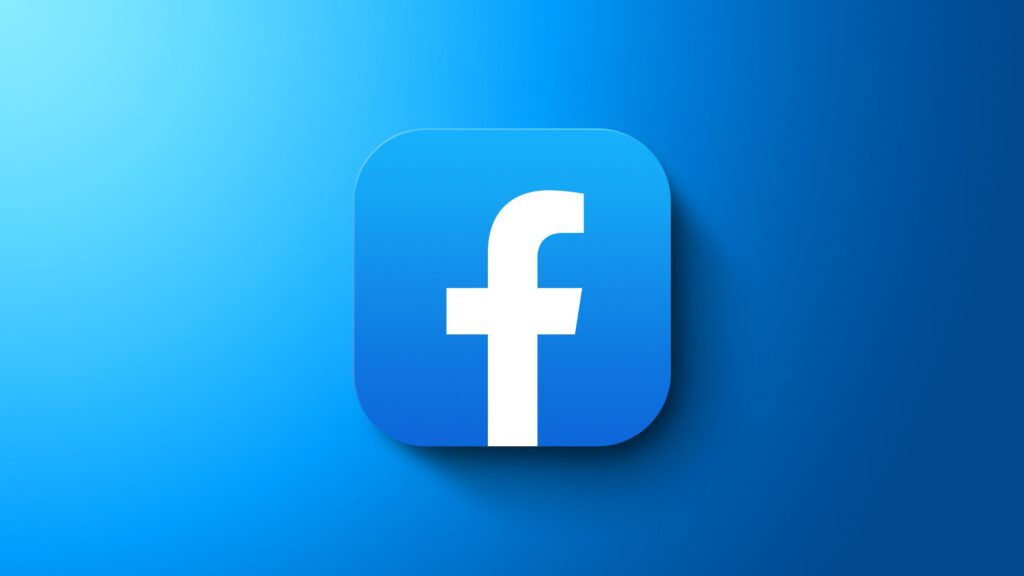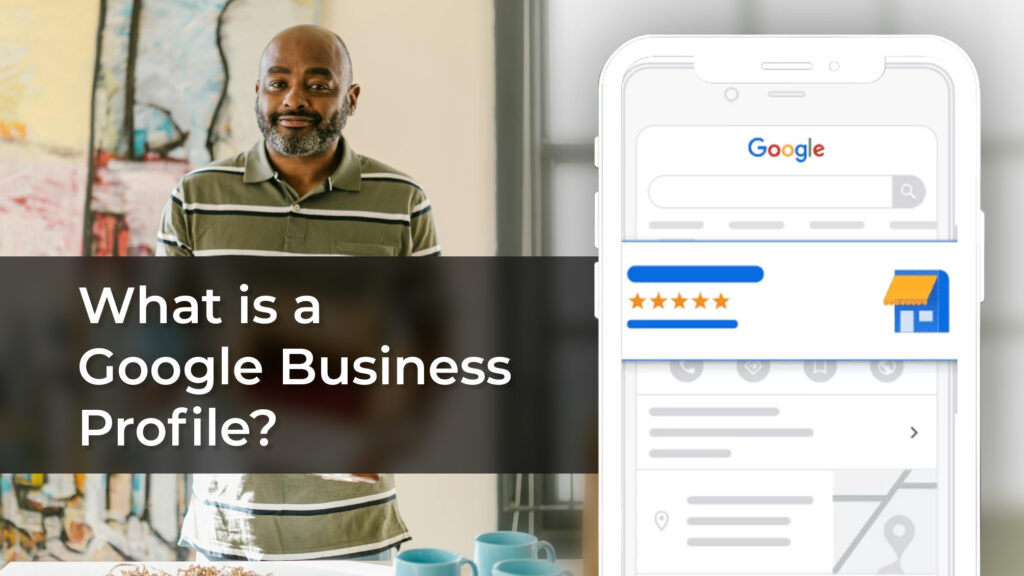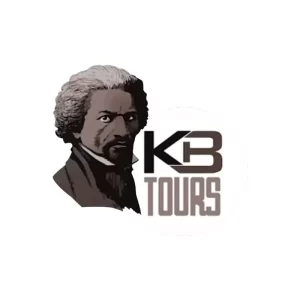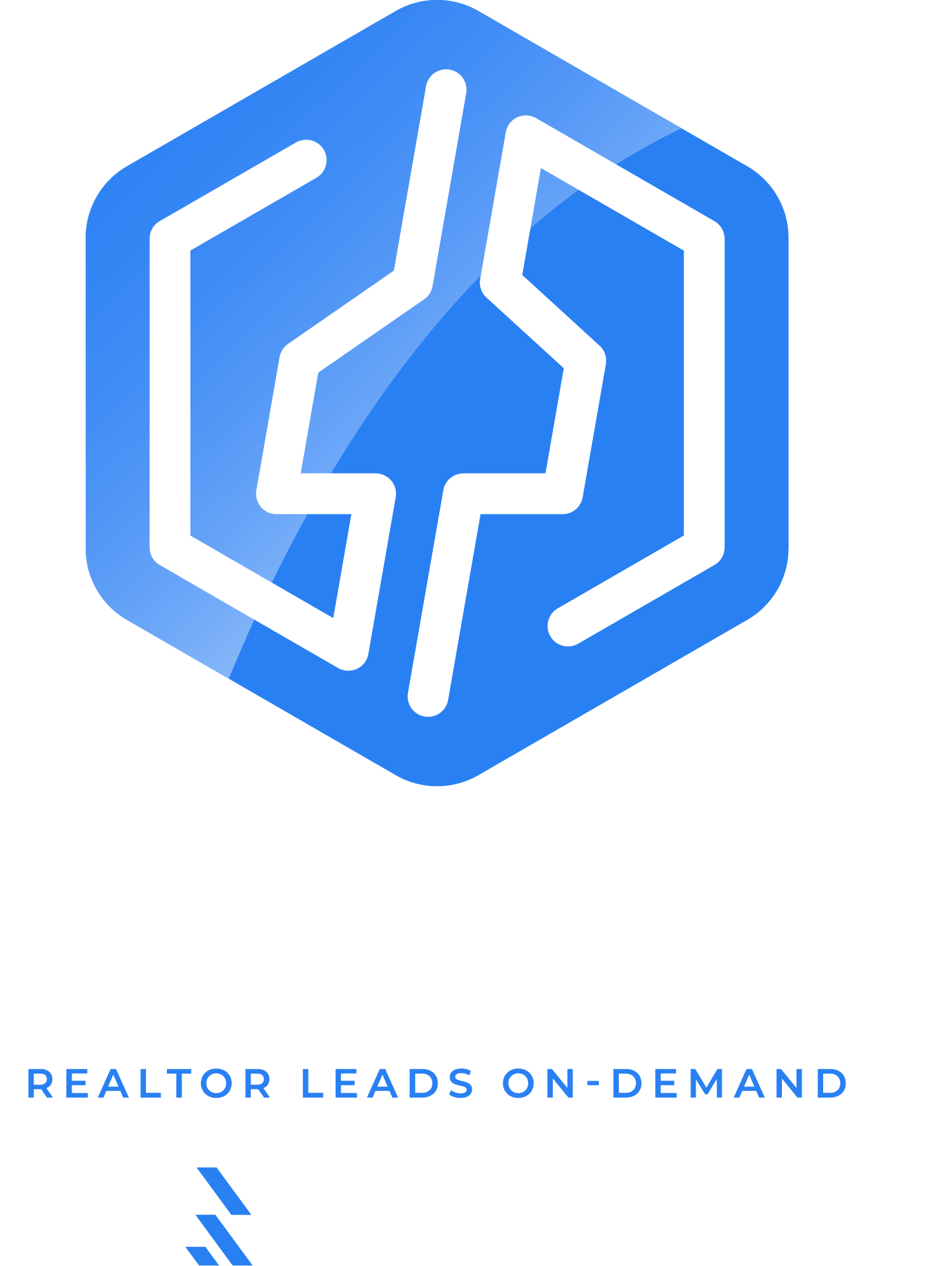B2B Marketing is the process of marketing B2B products or services by a business with the goal of selling to another business.
B2B companies, such as manufacturers and tech companies, use B2B digital marketing plans to increase brand awareness and generate more leads
And like B2C marketing, which we will talk about below, B2B marketing uses methods like email, content, social media, video, and other B2B digital marketing and communications strategies to make themselves more accessible as a brand and more viable as a B2B solution to their prospective customers.
To learn more about key B2B marketing strategies, read our article, B2B Marketing Strategies: What You Need to Know in 2021.
What is B2B?
B2B Is short for “business to business”, which refers to any business that sells products or services to other businesses and not directly to consumers or individual consumers.
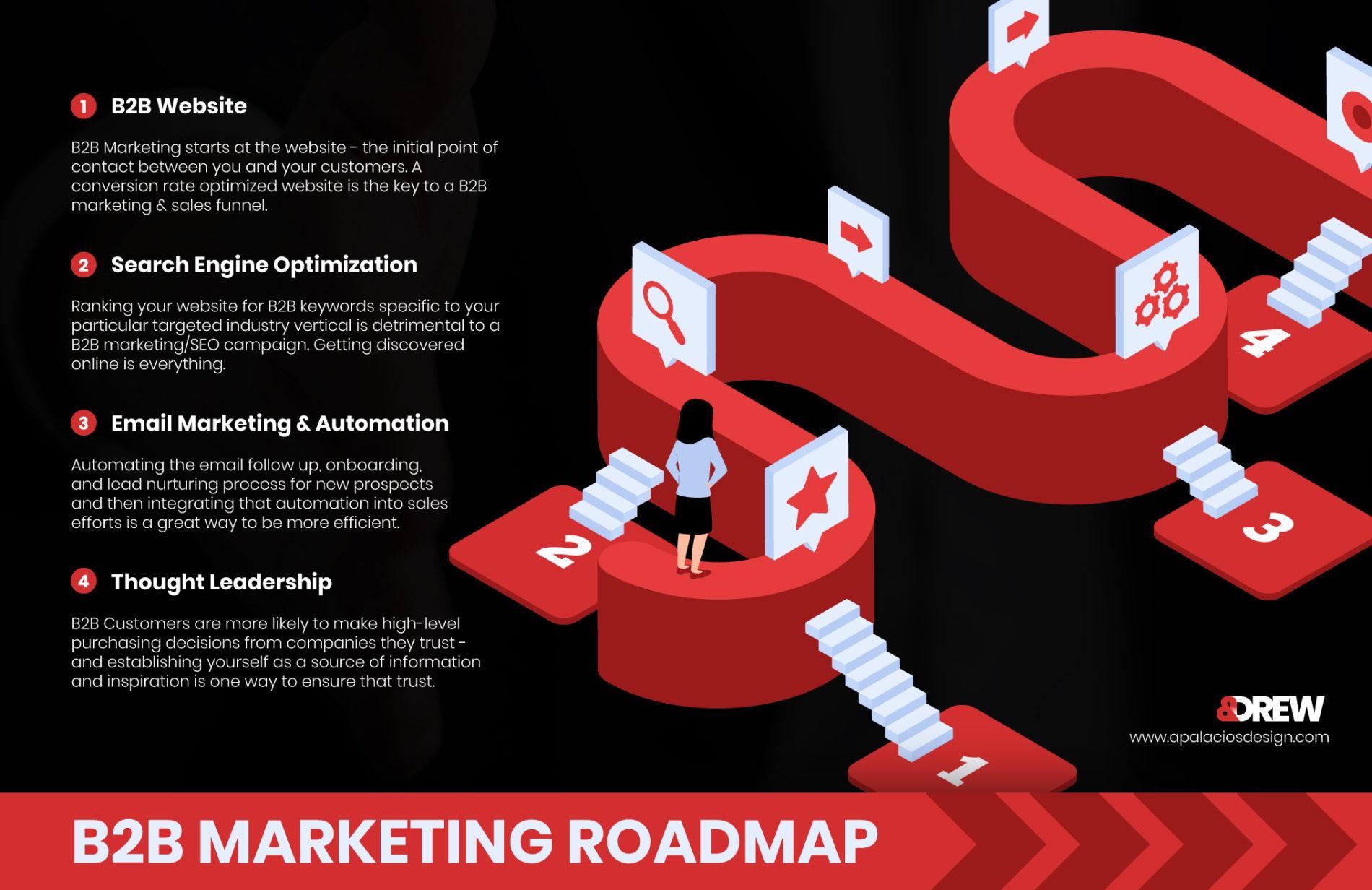
B2B businesses are companies that profit off of supporting other businesses in their daily operations, either by providing goods or services and who do not sell directly to consumers – because the truth is that B2B products and services just aren’t the right fit for the consumer market.
B2B Products and services are typically priced for businesses, not for consumers – meaning that pricing can vary from several thousand dollars to upwards of $1m and beyond. Businesses that provide these kinds of solutions range from industrial manufacturers and suppliers to software companies and ERP solutions.
B2B products in the B2B model can vary just as widely as those in B2C models, in which the consumer (or “end-user”) purchases a product directly from a company.
What’s the difference between B2B marketing and B2C marketing?
It’s important to understand the key differences between B2B marketing and B2C marketing so that B2B marketers can perform better and achieve more dramatic results.
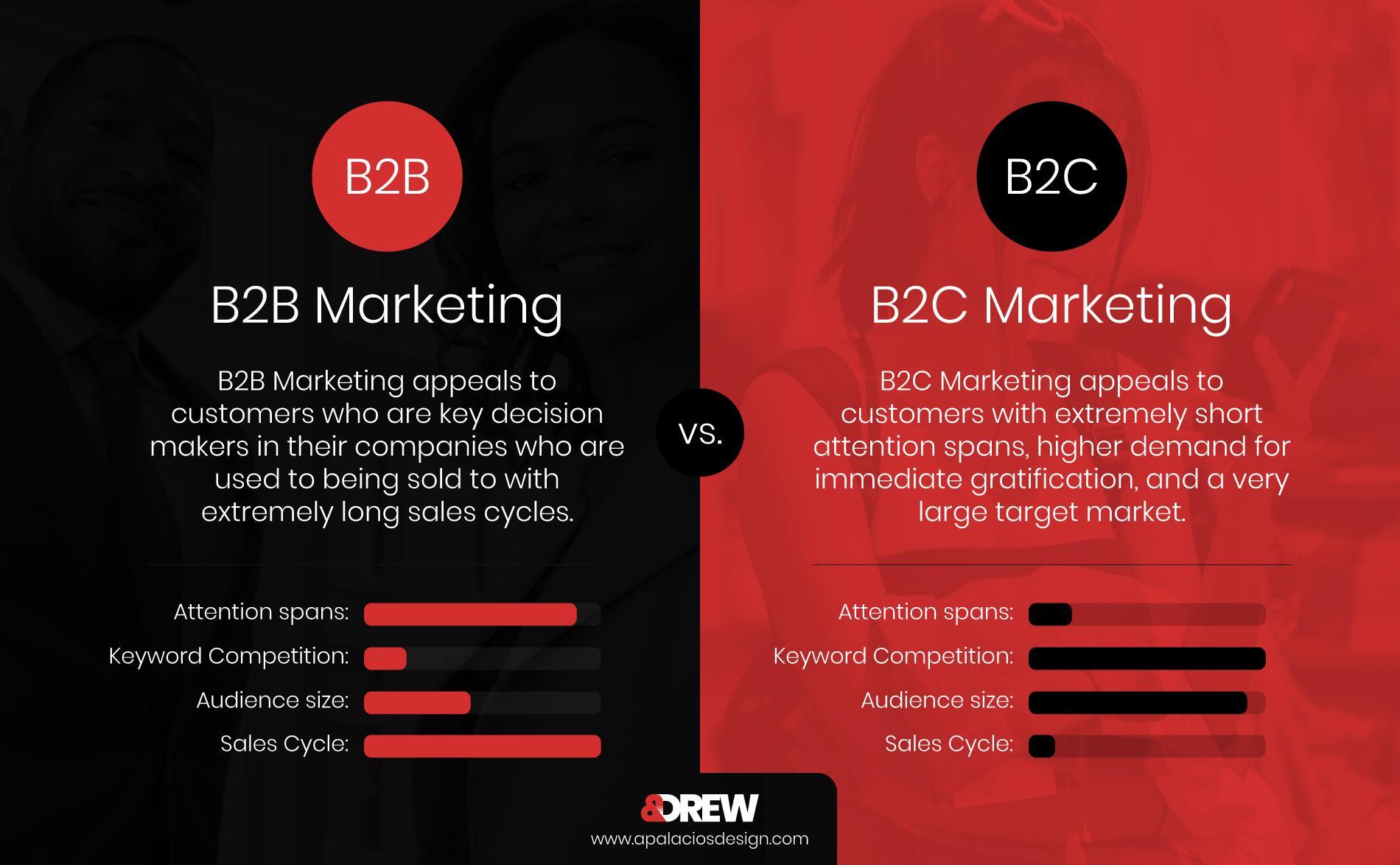
In B2B marketing, the most important goal is to establish positive relationships with key decision makers in companies that you sell do – whether these are office managers, sales representatives, VPs, CMOs, or even CEOs.
Because of this small audience, targeting is much easier and more effective with B2B than it is with B2C due to not needing to use as many resources in order to make as many waves as possible.
In addition to being a generally smaller audience, B2B customers have considerably longer attention spans and extremely long sales cycles compared to consumers.
1. B2C Customers have very short attention spans.
B2C Customers have short attention spans – it’s just a fact of life.
They expect value now, and will be disappointed if they cannot receive the instant gratification that they’ve come to expect from B2C brands due to social media reviews and other consumable content which they can mow down faster than you can spell “sales cycle”.
It’s not because B2C customers are dumb – in fact, it’s quite the opposite.
B2C Customers have, through decades of experiencing unwelcome advertising, commercials, product placements, and other assaults on their attention spans, developed a sort of “marketing filter” that allows them to instantly see through marketing campaigns and make decisions instantly regarding whether or not a product can provide value to them based on factors such as:
- Social proof
- Past experience
- Reviews & testimonials
- Personal level of interest
This phenomenon is probably because B2B buyers need to pay attention to ads and marketing campaigns because they are always functioning with a competitive mindset, and are constantly seeking a competitive advantage over other businesses. In business-to-business marketing, marketing and advertising are not as common as they are in B2C, either because of a lack of resources on their marketing departments’ end, or a lack of any sense of urgency regarding marketing.
B2B customers actually pay attention to ads, and in some cases (such as industry magazines, online directories/listings), B2B customers are actually looking for ads to determine whether or not a product or service can be deemed valuable to them.
2. B2B Customers are always on their A-game.
B2B Customers can’t afford to slack off when it comes to making decisions regarding what ERP solution to purchase, or what software will best help their customer service team, or which metal fabrication provider to purchase from that makes the most sense, logistically.
Again, this ties back into the fact that most B2B customers are key decision-makers in high-level positions of power within their companies, which not only pushes them towards constantly looking for better solutions but also forces them to waft through many bad, poorly thought out B2B marketing campaigns and advertisements.
Due to overexposure to a plethora of bad marketing (again, due to lack of resources of a lack of a sense of urgency on the marketer’s part), B2B customers tend to notice good marketing, which makes marketing to them that much easier – all you need to do is catch them off guard!
Examples of a B2B marketing strategy that works in 2022:
An effective B2B marketing plan/strategy borrows elements from B2C marketing and applies B2B principles and values to them.
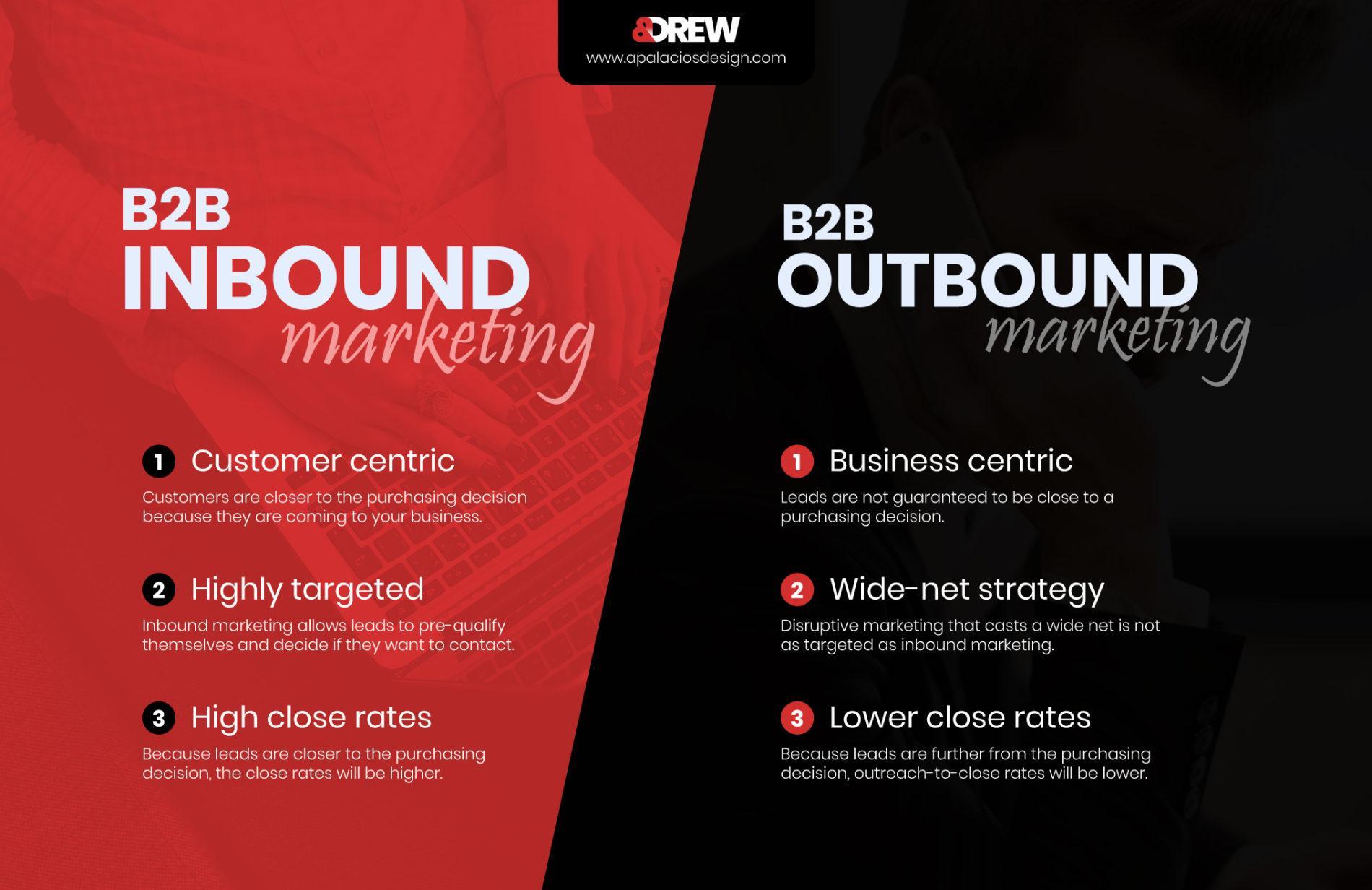
There are so many different B2B marketing strategies that all have their own unique benefits (and pitfalls), but ultimately it all boils down to two primary categories of marketing:
1. Inbound marketing vs. outbound marketing.
When considering which B2B marketing strategy is best for your business’ marketing campaign efforts – inbound vs. outbound – consider the following questions:
- Will your prospects appreciate a proactive approach to marketing + sales, or will they become annoyed if you perform an outbound campaign?
- Does your business currently have a customer relationship management system (CRM) in place that will help manage inbound leads, or will some get lost in the mayhem?
- Consider your current marketing approach, and determine whether or not a drastic shift in direction would be beneficial or harmful to your bottom line.
- Does your sales team have the resources to follow up with dozens, hundreds, or thousands of inbound leads every month, or will some slip through the cracks?
Every B2B marketing team needs an effective strategy in order to generate leads for sales teams – get inspired by these B2B marketing strategy examples.
B2B Marketing strategies should always be deployed in a way that is unique and personalized to your industry, business, and B2B customers – it is never recommended to copy another brand’s marketing strategy – but we can absolutely learn from past B2B marketing campaign examples!
2. Email marketing.
Email marketing has been an effective channel for B2B marketing campaigns since the mid-1990s when email was introduced as a commercially available service. And there’s a good reason that email marketing has stuck around for so long:
59% of B2B markers say that email marketing is their most effective marketing channel compared to other strategies, and more importantly, over 85% of key decision-makers prefer to use email over other modes of communication when interacting with businesses and employees.
3. Email automation & nurturing campaigns.
B2B Customers are highly independent and qualified to do research into the products + services they need to buy (and if they’re not, they can afford someone to perform process improvement for them), so it makes sense to stay in B2B customers’ peripheral without coming off as overly pushy, or annoying.
One way to achieve this is to favor email automation marketing as opposed to frequent eBlast campaigns.
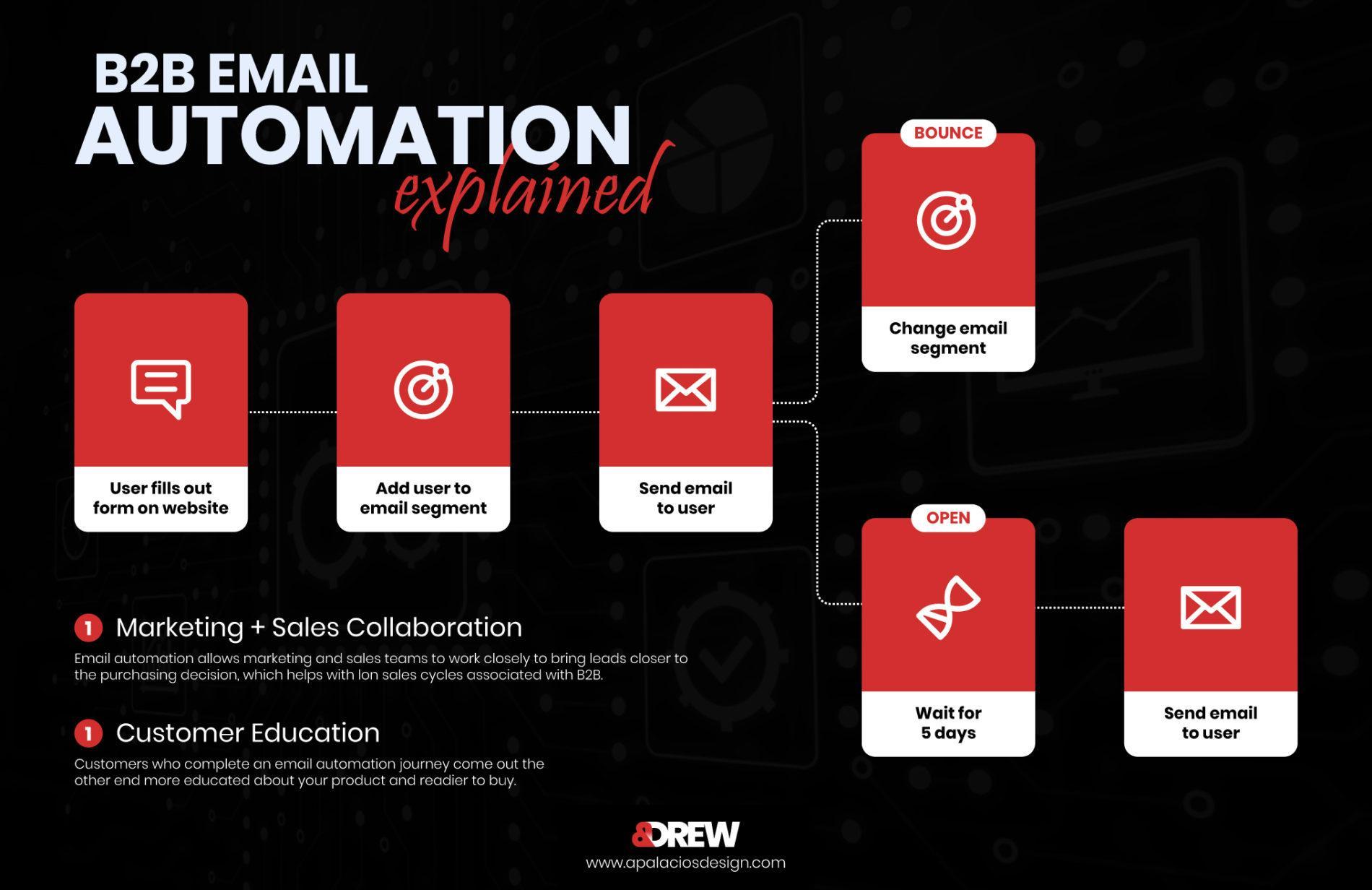
B2C Brands often send 3-6 eBlast email campaigns per week, which can lead to consumer burnout and a decrease in open and click rates. Essentially, what B2C brands are doing is training their email lists not to open their emails, because if they miss it, it’s no big deal – they can just check tomorrow’s email.
B2B Brands need to operate differently, and include a higher level of value in email campaigns over a longer period of time – this compensates for the exceedingly long sales cycles often experienced by most B2B industries. One way to do this is through email automation or a nurturing campaign.
An email nurturing campaign is a series of drip emails, sent one after another in intervals of days, weeks, or even months, all serving a specific purpose and providing value to the recipient. Nurturing campaigns are the best way to reel new B2B customers in, because they are allowed to move at their own pace and not need to check emails every day to “not miss a beat”.
- Interested B2B prospective customer subscribes to a mailing list or newsletter through a lead capture form in order to receive more information or gated content.
- Immediately after subscribing, the prospect receives an onboarding email with a well-placed call to action, and lets them know what the next step is.
- After a certain period of time, a new email is automatically sent to the prospect, repeating the call to action and providing more value.
- This process is repeated for as long as it takes for the customer to convert, or until a certain number of emails have been sent – at which point, a sales rep can call the customer and introduce themselves.
4. Content marketing.
Like email marketing, the goal of B2B content marketing is to provide value upfront (a strategy that is borrowed from B2C marketing, i.e. “instant gratification”). B2B Content marketers understand the relationship between B2B customers and B2B sellers and know exactly how to talk to customers in a way that engages with them, challenges their workflow, and proposes a solution to them.
All customers, whether B2B or B2C, can appreciate good content.
It provides value, entertains them, and educates them on a topic that they’re interested in learning about. No one is forced to read content, people click on links because they want to read what’s inside. It’s important to appeal to the consumer mindset in B2B marketers and engage their human curiosity – an element that can often be forgotten in B2B marketing strategies.
A great example of a B2B content marketing strategy is the Hubspot Blog.
Hubspot is a customer relationship management (CRM) software and marketing automation suite that allows sales teams to track deals across the sales funnel, as well as set up automation to make their jobs a little bit easier.
Hubspot determined that a great way to engage with its B2B customers would be to implement a B2B blog and resource hub of information. As you can see, the blog has sections where readers can enter their contact information, which allows Hubspot to then implement a powerful email marketing and lead nurturing campaign (like the one we talked about above).
Here are some of the benefits of blogging for B2B:
- Increase search engine visibility and overall SEO
- Provide better content to B2B readers for more educated customers
- Reduce the amount of time spent on educating customers
- Position your brand as a thought leader (more on that below!)
5. LinkedIn marketing & thought leadership.
B2B Marketing in 2022 and beyond is all about thought leadership and presenting your business as not only a valuable B2B solution for your customers but also a trustworthy source of valuable information and digestible content that B2B readers will thoroughly enjoy.
By positioning yourself or your B2B brand as a thought leader in your immediate community, you are effectively putting a face to the name and making connections with your potential customers on a human level – something that everyone enjoys, even B2B customers!
Marketing teams can implement LinkedIn thought leadership within their own ranks by buffing up their LinkedIn accounts and engaging with their ideal audience using strategically positioned content that serves to gently push the B2B brand’s message, while also serving to present authenticity and value.
Thought leadership on LinkedIn is an extremely effective B2B strategy because LinkedIn is a highly active B2B marketing channel. Here are some ideas that your B2B marketing team can implement to begin a more effective LinkedIn B2B marketing campaign today:
- Get corporate headshots taken, and use them as your LinkedIn portfolio image.
- Design a branded LinkedIn banner for your B2B marketing and sales team, and make everyone use it to create a sense of belonging/branding.
- Completely fill out profiles, and have team members follow your B2B LinkedIn business page.
- Share and post thoughtful content to LinkedIn, and have key team members share it on their personal LinkedIn profiles to a more engaged audience.
6. Case studies & white papers.
Another thing that B2B customers absolutely love is published case studies/case histories and white papers detailing services, past results, and testimonials.
Case studies are the B2B equivalent of “social proof”, which is a B2C term used to define the feeling of trust that a business earns when it demonstrates that it has provided value to other customers who voice their positive opinions about the brand/product.
In B2B marketing, social proof still matters – it just looks different.
Instead of Instagram comments, or Google/Yelp reviews, B2B customers rely on white papers, case studies, and client testimonials for their social proof.
Many B2B businesses provide this content upfront, and it’s possible to access this information on their website – however, a great technique used by many experienced B2B marketers is to offer case studies + white papers as “gated content” on their websites.
Gated content is content that is only accessible to users who enter their contact information – thus entering them into your B2B email marketing campaign and making them available to receive email newsletters from your business, as well as entering your sales funnel.
Your team can implement this today by assessing what content you already have in terms of case studies, testimonials, and other white papers and then sprucing them up – i.e. turning them into sales collateral, instead of static materials.
Represent this content in a way that implies that it is valuable to B2B customers, and they will begin to fight for access to it – believe me.
7. Paid media marketing.
You didn’t really think we’d completely avoid mentioning paid marketing, did you?
B2B Is a pay-to-play environment, where the big fish eat the little fish for breakfast. If you aren’t spending, then you aren’t earning a dime.
In B2B, paying for advertisements can get pricey, and that’s because there are simply fewer customers to go around. You will find yourself fighting tooth and nail for access to the same competitive bid keywords that your competitors are advertising for, and paying up to as much as $20/click – all in the name of digital marketing.
But in the end, it’s worth it – remember what we talked about earlier: B2B products and services cost anywhere between a few thousand dollars to as much as $1m in sales – so paying $20/click suddenly doesn’t seem like such a bad figure, huh?
In B2B marketing, it’s important to calculate and project your return on ad spend (ROAS) so that you can accurately determine the success of paid media campaigns or identify bottlenecks in existing ads.
8. B2B marketing automation.
Smart B2B marketers implement marketing automation at the proper points along their workflow to get more done, efficiently.
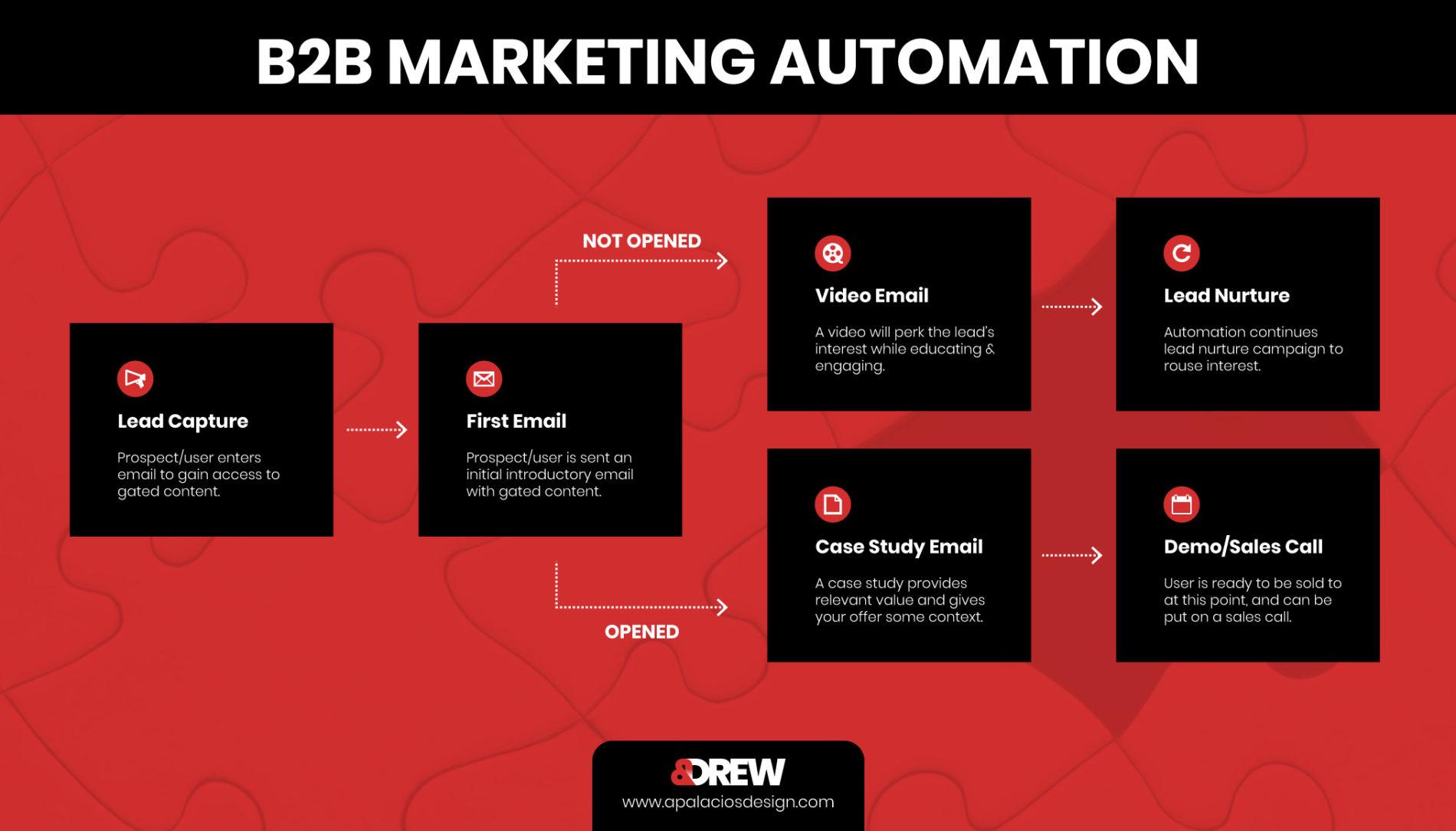
Marketing automation allows marketing and sales teams to automate parts of their workflow, such as follow-up emails and scheduling, enabling them to spend more time on other important tasks such as calling customers on the phone or collaborating on new marketing campaigns.
In terms of B2B, marketing automation includes the support of customized & personalized emails, landing page automation, and internal scheduling/task management.
B2B Marketing automation allows for more efficient salespeople, smarter marketers, and happier customers.
Conclusion & references.
If you still are having a hard time understanding B2B marketing, here are some more references you can use for your own research.
Thank you for reading our explanation of B2B marketing, strategy, and examples. We hope that you found some value in our post. Please share this article with your marketing team, in case you think they could use a refresher on the topic!
Below are some additional articles by other bloggers who have covered the topic, and other topics, pretty extensively.
























